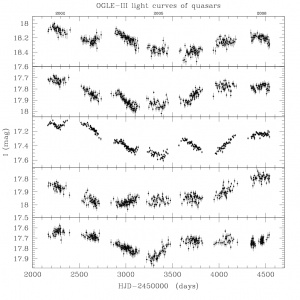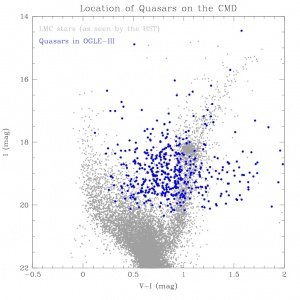Difference between revisions of "Triggers:AGN"
m |
m |
||
| (6 intermediate revisions by the same user not shown) | |||
| Line 1: | Line 1: | ||
== Active Galactic Nuclei (AGNs) == | == Active Galactic Nuclei (AGNs) == | ||
| + | |||
| + | [[File:AGN_lc.jpg|300px|thumb|Exemplary light curves of quasars]] | ||
(AGN is a term for a broader group of objects including: quasars, quasi-stellar objects (QSOs), Seyfert 1/2 galaxies, blazars, etc.) | (AGN is a term for a broader group of objects including: quasars, quasi-stellar objects (QSOs), Seyfert 1/2 galaxies, blazars, etc.) | ||
| Line 5: | Line 7: | ||
'''AGNs:''' They are cosmologically distant sources, that can be used for fixing reference frames for studying motions of stars in the Galaxy and in the nearby galaxies within the Local Group. The majority of AGNs would be the most energetic objects in the Universe. | '''AGNs:''' They are cosmologically distant sources, that can be used for fixing reference frames for studying motions of stars in the Galaxy and in the nearby galaxies within the Local Group. The majority of AGNs would be the most energetic objects in the Universe. | ||
| − | A widely accepted model for active galactic nuclei nowadays is that their emission is caused by release of gravitational energy during | + | A widely accepted model for active galactic nuclei nowadays is that their emission is caused by the release of gravitational energy during accretion of matter onto super-massive black holes residing in the very centers of galactic nuclei. Following the unified model of AGNs, we can crudely divide them into high (M_V < -23 mag) and low (M_V > -23 mag) luminosity objects. In the high luminosity AGNs emission comes either from the jet of relativistic matter pointing towards the observer (blazars), from the vicinity of the nucleus (QSOs) or from both. The observed optical variability in these objects, if present, has the shortest characteristic time-scales of days or weeks, what puts an upper limit on the size of the emission region, ie., r < 0.01 pc or approximately r < 10^16 cm. Low luminosity AGNs depending on the inclination angle of the accretion disk are Seyfert 1 if the disk is close to face-on or Seyfert 2 if it closer to edge-on. The face-on position allows to directly probe the very inner region of the AGNs -- the accretion disk (and Broad emission Line Region). This is where the most energetic radiation originates from, including X-ray, UV flux and optical continuum. Once the inclination angle of the disk changes from face-on to the edge-on, the dust torus begins to obscure the accretion disk as well as the Broad emission Line Region (BLR). Part of the emitted light is then being absorbed by the dust torus and re-radiated in a form of thermal radiation at longer, infrared wavelengths. |
| − | accretion of matter onto super-massive black holes residing in the very centers of galactic nuclei. Following the unified model of AGNs, we can crudely divide them into high and low luminosity objects. In the high luminosity AGNs emission comes either from the jet of relativistic matter pointing towards the observer (blazars), from the vicinity of the nucleus (QSOs) or from both. The observed optical variability in these objects, if present, has the shortest characteristic time-scales of days or weeks, what puts an upper limit on the size of the emission region, ie., r < 0.01 pc or approximately r < 10^16 cm. Low luminosity AGNs depending on the inclination angle of the accretion disk are Seyfert 1 if the disk is close to face-on or Seyfert 2 if it closer to edge-on. The face-on position allows to directly probe the very inner region of the AGNs -- the accretion disk (and Broad emission Line Region). This is where the most energetic radiation originates from, including X-ray, UV flux and optical continuum. Once the inclination angle of the disk changes from face-on to the edge-on, the dust torus begins to obscure the accretion disk as well as the Broad emission Line Region (BLR). Part of the emitted light is then being absorbed by the dust torus and re-radiated in a form of thermal radiation at longer, infrared wavelengths. | ||
| − | '''Spectra:''' The spectra of AGNs are often roughly divided into a `blue bump' and an `infrared bump'. Emission at short wavelengths is caused by an optically thin accretion disk radiating with a power-laws <math>T | + | '''Spectra:''' The spectra of AGNs are often roughly divided into a `blue bump' and an `infrared bump'. Emission at short wavelengths is caused by an optically thin accretion disk radiating with a power-laws <math>T \propto R^{-3/4}</math> (and <math>R \propto \lambda^{4/3}</math>). |
Dust grains evaporate above ~2000 K, what corresponds to a local minimum at <math>\lambda=1 \mu</math>m in the AGNs spectral energy distributions (SEDs). The `infrared bump', for wavelengths longer than 1 <math>\mu</math>m, is believed to be a fingerprint of hot dust re-radiating more energetic radiation. | Dust grains evaporate above ~2000 K, what corresponds to a local minimum at <math>\lambda=1 \mu</math>m in the AGNs spectral energy distributions (SEDs). The `infrared bump', for wavelengths longer than 1 <math>\mu</math>m, is believed to be a fingerprint of hot dust re-radiating more energetic radiation. | ||
| − | + | [[File:AGN_cmd.jpg|300px|thumb|Quasars on a CMD of the Large Magellanic Cloud]] | |
| − | |||
| − | ''' | + | '''Optical appearance:''' The majority of AGNs up to a redshift of z < 2.6 occupy colors of 0.4 < (''V-I'') < 1.0 mag. The characteristic long-term aperiodic variability of AGNs, in the optical part of the spectrum, has an average amplitude of ~0.3 magnitude in ''I''-band. |
| − | + | '''Spatial distribution on the sky:''' There are approximately 0.4, 4 and 40 AGNs per square degree brighter than ''I'' < 16, 18 and 20 mag, respectively. | |
| − | |||
| − | |||
| − | + | '''Links:''' | |
[http://astro.ia.uz.zgora.pl/~simkoz/projects/AGN_MC/database/ Database of Quasars Behind the Magellanic Clouds] | [http://astro.ia.uz.zgora.pl/~simkoz/projects/AGN_MC/database/ Database of Quasars Behind the Magellanic Clouds] | ||
Latest revision as of 15:33, 26 August 2009
Active Galactic Nuclei (AGNs)
(AGN is a term for a broader group of objects including: quasars, quasi-stellar objects (QSOs), Seyfert 1/2 galaxies, blazars, etc.)
AGNs: They are cosmologically distant sources, that can be used for fixing reference frames for studying motions of stars in the Galaxy and in the nearby galaxies within the Local Group. The majority of AGNs would be the most energetic objects in the Universe.
A widely accepted model for active galactic nuclei nowadays is that their emission is caused by the release of gravitational energy during accretion of matter onto super-massive black holes residing in the very centers of galactic nuclei. Following the unified model of AGNs, we can crudely divide them into high (M_V < -23 mag) and low (M_V > -23 mag) luminosity objects. In the high luminosity AGNs emission comes either from the jet of relativistic matter pointing towards the observer (blazars), from the vicinity of the nucleus (QSOs) or from both. The observed optical variability in these objects, if present, has the shortest characteristic time-scales of days or weeks, what puts an upper limit on the size of the emission region, ie., r < 0.01 pc or approximately r < 10^16 cm. Low luminosity AGNs depending on the inclination angle of the accretion disk are Seyfert 1 if the disk is close to face-on or Seyfert 2 if it closer to edge-on. The face-on position allows to directly probe the very inner region of the AGNs -- the accretion disk (and Broad emission Line Region). This is where the most energetic radiation originates from, including X-ray, UV flux and optical continuum. Once the inclination angle of the disk changes from face-on to the edge-on, the dust torus begins to obscure the accretion disk as well as the Broad emission Line Region (BLR). Part of the emitted light is then being absorbed by the dust torus and re-radiated in a form of thermal radiation at longer, infrared wavelengths.
Spectra: The spectra of AGNs are often roughly divided into a `blue bump' and an `infrared bump'. Emission at short wavelengths is caused by an optically thin accretion disk radiating with a power-laws <math>T \propto R^{-3/4}</math> (and <math>R \propto \lambda^{4/3}</math>).
Dust grains evaporate above ~2000 K, what corresponds to a local minimum at <math>\lambda=1 \mu</math>m in the AGNs spectral energy distributions (SEDs). The `infrared bump', for wavelengths longer than 1 <math>\mu</math>m, is believed to be a fingerprint of hot dust re-radiating more energetic radiation.
Optical appearance: The majority of AGNs up to a redshift of z < 2.6 occupy colors of 0.4 < (V-I) < 1.0 mag. The characteristic long-term aperiodic variability of AGNs, in the optical part of the spectrum, has an average amplitude of ~0.3 magnitude in I-band.
Spatial distribution on the sky: There are approximately 0.4, 4 and 40 AGNs per square degree brighter than I < 16, 18 and 20 mag, respectively.
Links:

